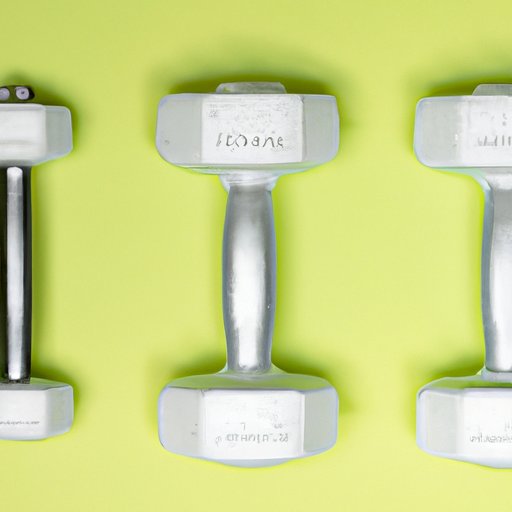
Introduction
Weight bearing exercise refers to any activity that requires an individual to support their own weight through their feet and legs, or through their hands and arms. This type of exercise is essential for maintaining strong bones, muscles, and overall health.
Defining the Benefits of Weight Bearing Exercise: A Beginner’s Guide
Weight bearing exercise is crucial for overall health. Aside from building strong bones and muscles, regular weight bearing exercises can also improve balance, coordination and flexibility, which can help prevent falls and injuries. Additionally, weight bearing exercises can burn up calories and reduce the risk of chronic diseases such as diabetes and heart disease.
Benefits of weight-bearing exercise for bone health
Weight bearing exercise is essential for building and maintaining strong bones. Bones are living tissues that adapt and respond to the demands placed on them. Weight bearing exercises help create tension in the bones, which triggers the body to produce more bone tissue to help meet the increased demand. Over time, this leads to stronger and denser bones that are more resistant to fractures and osteoporosis (bone loss).
Exploring the Science Behind Weight Bearing Exercise
Weight bearing exercise affects bones and muscles in a variety of ways. By applying stress to bones and muscles, weight bearing exercises help stimulate the growth of new bone tissue and muscle fibers. Exercise also helps improve the efficiency of the body’s circulatory and respiratory systems, delivering essential nutrients and oxygen throughout the body more efficiently.
Role of weight bearing exercise in preventing age-related bone loss
As we age, our bones become less dense and more prone to fractures. Weight bearing exercise has been shown to be an effective way of counteracting this age-related bone loss. A study published in the Journal of Bone and Mineral Research found that adults who participated in high-impact weight-bearing activities had higher bone mineral density than those who participated in low-impact activities.
5 Weight Bearing Exercises to Incorporate into Your Fitness Routine
There are a variety of weight bearing exercises you can add to your fitness routine to help strengthen your bones and muscles. Here are five examples:
1. Walking
Walking is a low-impact weight bearing exercise that is easy to incorporate into your day-to-day routine. Aim to walk at least 30 minutes a day, 5 days a week.
2. Squats
Squats are a compound exercise that work a variety of muscles in the lower body, including the quadriceps, hamstrings, glutes and calves. Begin with bodyweight squats and progress to weighted squats once you feel comfortable.
3. Push-Ups
Push-ups are a classic upper body exercise that works the chest, shoulders, triceps, and core. Begin with modified push-ups (knees on the ground) and progress to full push-ups.
4. Lunges
Lunges are a unilateral exercise that works the lower body, including the quadriceps, hamstrings, glutes, and calves. Begin with bodyweight lunges and progress to weighted lunges once you feel comfortable.
5. Step-Ups
Step-ups are a lower body exercise that works the quadriceps, hamstrings, glutes, and calves. Begin with a low height step and progress to a higher height once you feel comfortable.
Weight Bearing vs Non-Weight Bearing Exercises: What’s the Difference?
Non-weight bearing exercises refer to activities that do not require individuals to support their own weight through their feet and legs, such as swimming or cycling. While non-weight bearing exercises still provide many health benefits, they do not stimulate bone growth in the same way weight bearing exercises do.
Comparison of benefits of weight bearing vs non-weight bearing exercises
- Non-weight bearing exercises are great for people with joint pain or limited mobility, as they put less stress on the joints.
- Non-weight bearing exercises are also good for cardiovascular health, as they provide a low to moderate intensity aerobic workout that can help lower blood pressure and reduce the risk of heart disease.
- Weight bearing exercises are more effective at building strong bones and preventing osteoporosis.
- Weight bearing exercises are also effective for building muscle and improving overall fitness levels.
The Importance of Weight Bearing Exercise for Building Bone Density
Weight bearing exercise is essential for building bone density. Bones are living tissues that respond to the demands placed on them. Weight bearing exercises help create tension in the bones, which triggers the body to produce more bone tissue to help meet the increased demand. Over time, this leads to stronger and denser bones that are more resistant to fractures and osteoporosis.
Role of weight bearing exercise in preventing osteoporosis
Osteoporosis is a condition characterized by weak and brittle bones that are more prone to fractures. Women are particularly at risk of osteoporosis, as their bones tend to be smaller and less dense compared to men. Weight bearing exercise can help prevent osteoporosis by strengthening bones and improving their density.
How Weight Bearing Exercise Can Help Prevent Osteoporosis in Women
Osteoporosis is a major health concern for women as they age. In fact, according to the National Osteoporosis Foundation, women are four times more likely than men to develop the condition. Weight bearing exercise can help women prevent osteoporosis by strengthening bones and improving bone density.
The prevalence of osteoporosis in women
As women age, their risk of developing osteoporosis increases. According to the National Osteoporosis Foundation, approximately one in two women over the age of 50 will break a bone due to osteoporosis in their lifetime.
The importance of weight bearing exercise in preventing osteoporosis in women
Weight bearing exercise is essential for building and maintaining strong, healthy bones. Women who engage in regular weight bearing exercises are less likely to develop osteoporosis than those who do not. Additionally, weight bearing exercise can help improve balance and flexibility, reducing the risk of falls and fractures.
Conclusion
Weight bearing exercise is an essential component of overall health, particularly for bone density and preventing osteoporosis. Incorporating weight bearing exercises into your fitness routine can help you maintain strong bones, improve balance, and reduce the risk of falls and injuries.





